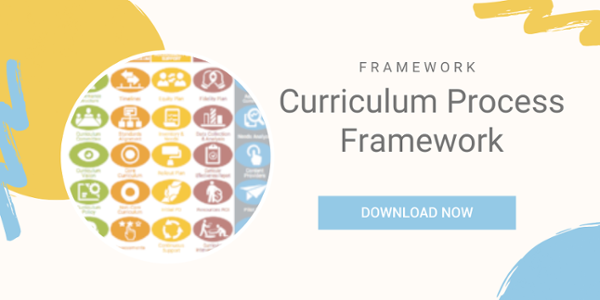Yes, I said it in my title. Life-changing. Am I exaggerating? Maybe a little. But as a former teacher, I met too many students who “hated (insert any subject here)” because they thought their textbook, worksheet, or homework material was boring, too difficult, or did not make sense to them. I also met too many fellow teachers who thought their curriculum was simply their textbooks (which they often didn’t like), and no more. For these students and teachers, learning and teaching was not a fun experience because their “curriculum” was horrible. Think about turning these people around and instilling joy in them through the right curriculum. Oh the things they will learn and teach! Isn’t that a life-changing possibility?
This is part 2 of my 3-part blog series about curriculum. Read the previous post for an introduction to the curriculum process framework to understand what we mean when we say curriculum. I hope you're excited to think about what the right curriculum can do. Now, let's talk about how one builds a process for managing a district-wide curriculum.
The framework above includes 4 functional capabilities that a district must establish in order for the curriculum process to be successful. They are:
- Policy & Oversight
- Written, Taught & Tested Curriculum
- Accessibility & Support
- Evaluation & Revision
In addition, there is a 5th functional capability that we have included when resources need to be updated and purchased on a cyclic basis -
5. Cyclic Resource Adoption
While there were a number of things that we thought through under each of these capabilities, below we have extracted the most essential questions to address from each functional area that will get you a quick-start when thinking through your own new curriculum process.
- Policy & Oversight
- Governance Structure - Is there a decision-making structure in place to determine what is to be written, taught, and tested?
- Curriculum Committee - Is there a committee accountable for annual analysis and revisions of what is to be written, taught, and tested? Are there clearly defined roles and responsibilities?
- Curriculum Vision - Is there a common understanding, clear purpose, and written commitments to guide what is to be written, taught, and tested?
- Curriculum Policy - Are there written policies to ensure all students have equal access to resources and instruction surrounding what is to be written, taught, and tested?
- Communication Plan - Is there a clear plan for communicating the current state and future changes to what is to be written, taught, and tested?
- Written, Taught & Tested Curriculum
- Timelines - Are there clear timelines and cycles for analysis and revisions of what is to be written, taught, and tested, as well as the adoption of new materials and resources?
- Standards Alignment - Has a gap analysis been performed to ensure your curriculum is aligned to all of the appropriate standards?
- Core Curriculum - Is there clearly written documentation identifying what is to be taught and tested in the core subject areas?
- Non-Core Curriculum - Is there clearly written documentation identifying what is to be taught and tested in the arts and other electives? Are there defined expectations surrounding interdisciplinary curricular components? Skills-based curriculum strategies (i.e. 21st Century skills, thinking skills, collaborative skills, etc.)?
- Assessments - Are benchmark assessments established?
- Accessibility & Support
- Equity Plan - Do community members, families, and teachers have access to the written curriculum? Do all classrooms, teachers, and students have equal access to the curricular materials and supplies?
- Inventory & Needs - Are there adequate materials to supply all classrooms in all schools? Do any classrooms have students with material needs that cannot be met without unique accommodations?
- Rollout Plan - Is there annual consideration for curriculum review and redistribution of materials to accommodate new staff and/or teachers of new courses? Is there a distribution strategy for newly adopted materials?
- Initial PD - Is there adequate professional development (PD) available for new staff and/or teachers of new courses? Is there thorough PD for teachers implementing newly adopted curricular resources?
- Continuous Support - Is curriculum-focused PD available at the district, school, and individual level? Is there a way for teachers to get immediate support and/or learning opportunities?
- Evaluation & Revision
- Fidelity Plan - Is there a plan to ensure that the written curriculum is being followed and the curricular resources are being used as they were designed?
- Data Collection & Analysis - Is data collected and grouped to ensure an accurate analysis of the impact of both the written curriculum and the adopted resources?
- Curricular Effectiveness Report - Are there strategies in place to allow for reporting and communicating the impact of both the written curriculum and the adopted resources?
- Resources ROI - Is there a strategy for evaluating the success of the adopted curricular resources against expectations and investment?
- Curricular Intervention Plan - Is there a process in place that allows for intervention when:
- the written curriculum is not being followed?
- the curricular resources are not being used as planned?
- the written curriculum is not meeting student needs?
- Cyclic Resource Adoption
- Adoption Committee - Is there a dedicated committee with representation from all stakeholders who have clear roles and responsibilities to ensure a successful resource adoption process?
- Needs Analysis - Has an analysis been conducted to assess the current resources and materials, as well as to determine the need for new resources and materials as identified in the pre-established timelines?
- Content Providers - Is there a plan to determine the content that will be considered for classroom materials and resources? Is there a need to have a formal presentation from all or some of the identified providers?
- Pilot Plan - Is there an established rubric for evaluating resources from content providers? Is there a plan to pilot some or all of the materials prior to purchasing?
- Procurement - Are the procedures, roles, and accountabilities to purchase needed resources and materials established and clear?
Be sure to download our framework and consider each question with your team, and add your own, as you review your current curriculum processes or consider a new curricular initiative in your district or school. If you’re not a part of your district’s curriculum committee, share this blog and resource with the right people and challenge them to think about these elements. With instructional standards, materials, and technology changing as rapidly as they have been in the last few years, establishing processes to ensure your curriculum and related resources are relevant, exciting, and useful for both learners and educators is more important than ever.
It is our duty as education leaders to provide the right process and structures for our schools to ensure they are implementing the most effective instructional pathways possible for today’s learners. With well-established processes for revising and maintaining curriculums and resources, we can ensure that our learners and educators are equipped with the right tools for joyful and relevant learning and teaching.
Keep an eye out for the last post in the series, all about developing a successful curriculum blueprint. Kickstart the process in your district by initiating a conversation with your curriculum team, and make sure you’re asking the important questions along the way. You can reach out to us on Twitter or email to share your thoughts and best practices used by your team!






